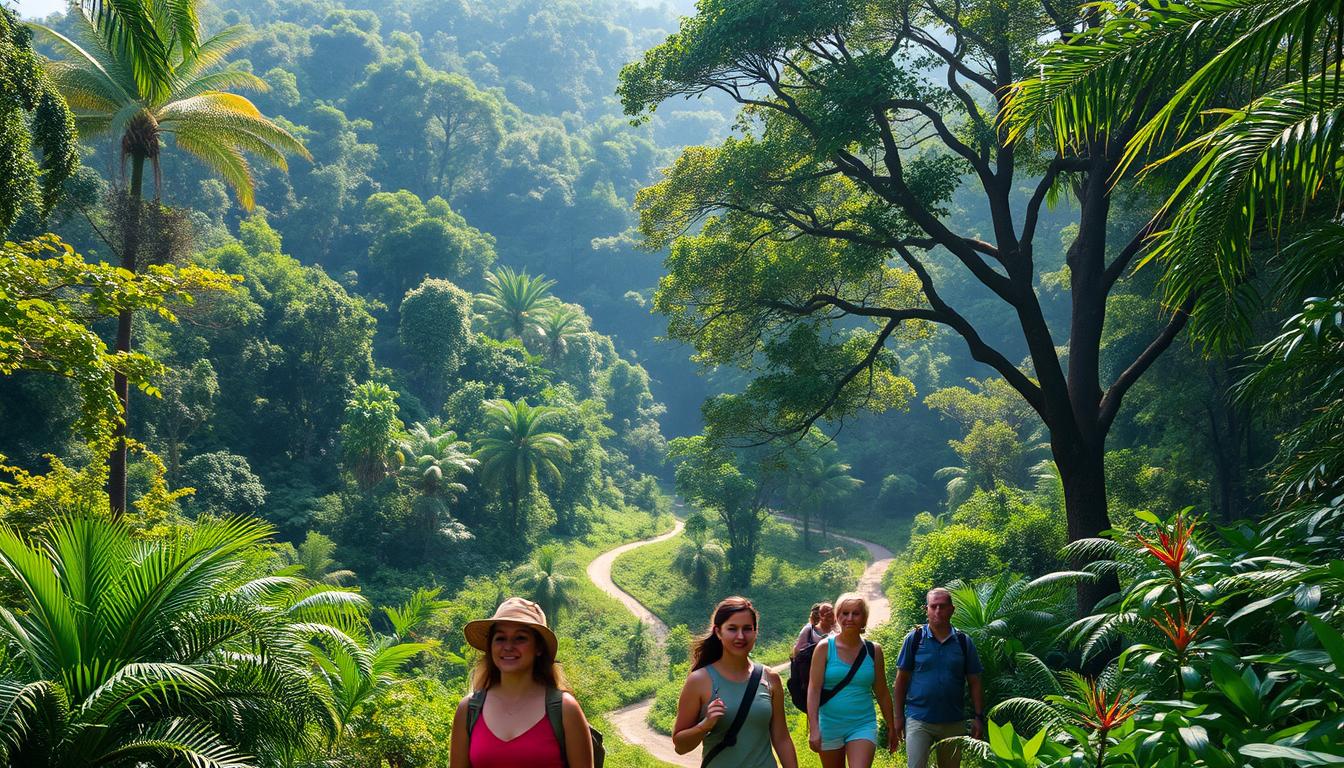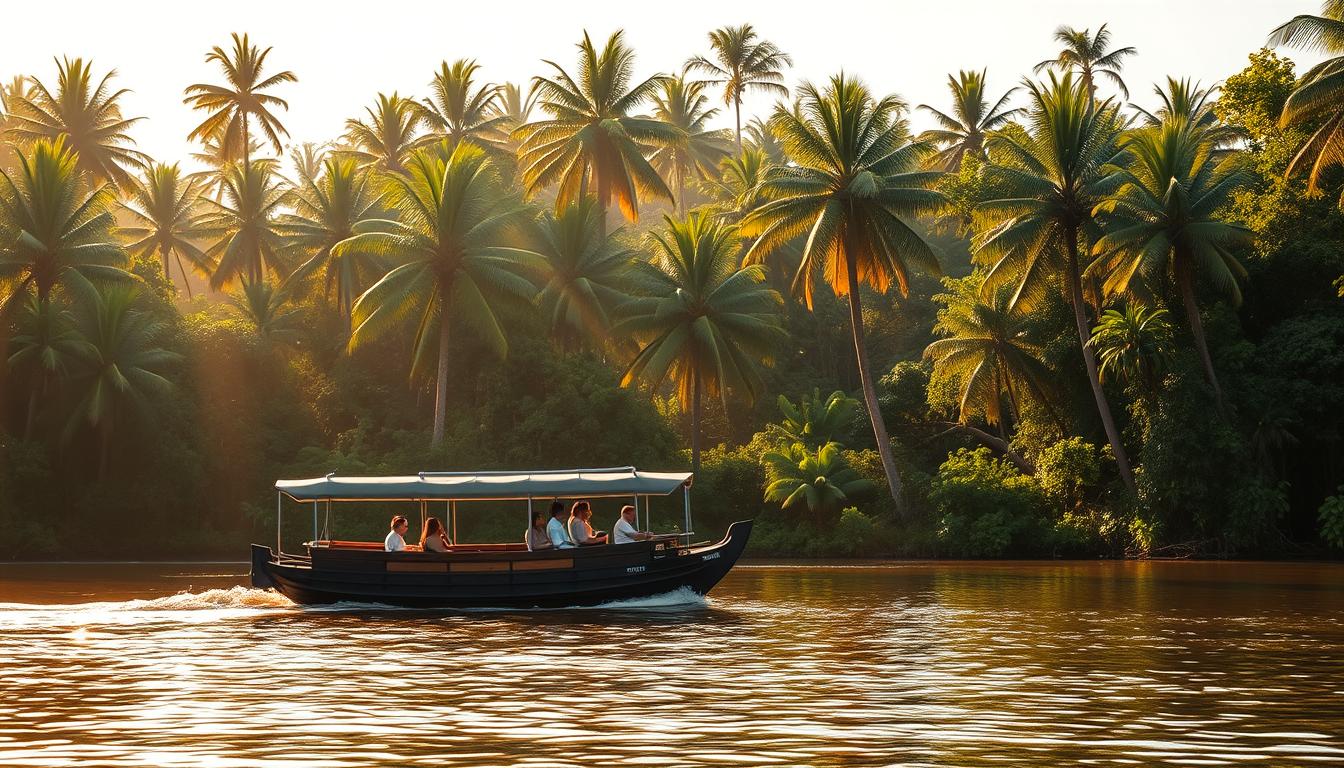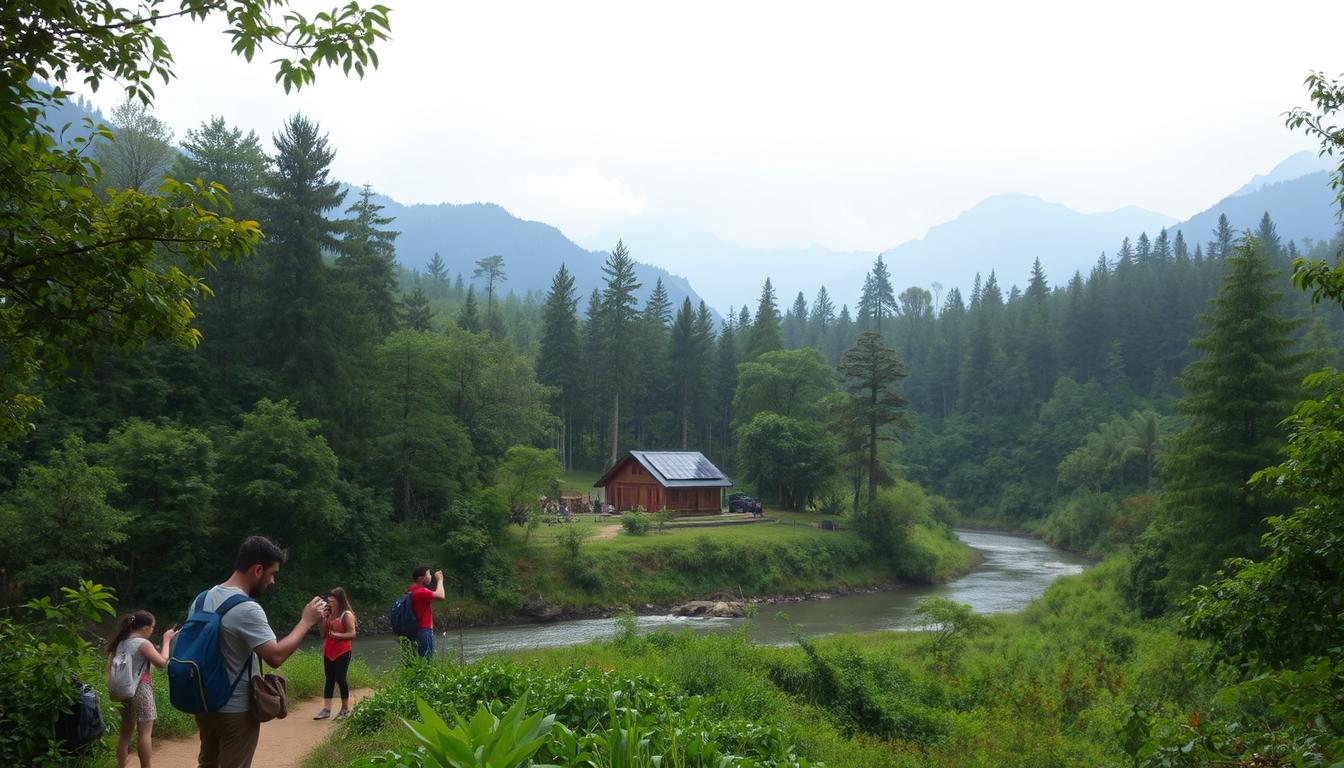Imagine standing in the midst of lush greenery, surrounded by the sounds of exotic birds and animals, with the majestic Amazon River flowing gently in the distance. This is what awaits you on an amazon rainforest tour, an adventure that promises to be an unforgettable experience.

As you embark on this rainforest adventure travel, you’ll have the opportunity to explore the vast landscapes, diverse wildlife, and indigenous cultures of the Amazon. With a focus on ecotourism in the amazon, this journey is not just about sightseeing, but also about contributing to the conservation efforts in place to protect this natural wonder.
Key Takeaways
- Explore the vast landscapes and diverse wildlife of the Amazon
- Experience the rich indigenous cultures
- Contribute to conservation efforts through sustainable tourism
- Enjoy an unforgettable adventure on an amazon rainforest tour
- Discover the importance of preserving the Amazon rainforest
The Magnificent Amazon: Nature’s Greatest Wonder
Stretching across nine countries in South America, the Amazon rainforest is an unparalleled natural wonder that captivates the imagination of travelers and scientists alike. This vast region is not just a geographical marvel but also a critical component of the global environmental balance.
Geography and Scale of the Amazon Basin
The Amazon Basin, covering an area of approximately 7 million square kilometers, is the largest river basin in the world. It encompasses a diverse range of ecosystems, including dense rainforests, flooded forests, and savannas.
Countries Encompassing the Amazon
The Amazon rainforest spans across nine countries: Brazil, Peru, Colombia, Venezuela, Ecuador, Bolivia, Guyana, Suriname, and French Guiana. Brazil holds the largest portion, with about 60% of the Amazon rainforest within its borders.
The Amazon River System
The Amazon River, the lifeline of the rainforest, is the largest river in the world by discharge volume. It stretches over 6,400 kilometers, flowing through Brazil, Colombia, and Peru, and is supported by thousands of tributaries.

Climate and Seasonal Variations
The climate in the Amazon varies significantly across the region, with distinct wet and dry seasons. The wet season typically brings heavy rainfall, while the dry season offers clearer skies and more accessible terrain for exploration.
Wet and Dry Seasons
The wet season, lasting from November to March, can make some areas inaccessible due to flooding. In contrast, the dry season, from April to October, is ideal for trekking and wildlife spotting.
Microclimate Diversity
The Amazon is characterized by a rich diversity of microclimates, ranging from the humid, tropical rainforest to the cooler, cloud forests at higher elevations. This diversity supports an incredible array of flora and fauna.
| Country | Percentage of Amazon Rainforest |
|---|---|
| Brazil | 60% |
| Peru | 13% |
| Colombia | 10% |
| Others | 17% |
A Journey Through the World’s Largest Rainforest: What to Expect
As the largest rainforest on Earth, the Amazon presents a unique opportunity to explore a vast array of ecosystems and cultures. Planning a trip to this magnificent region requires understanding the best times to visit and how to access its various parts.
Best Times to Visit Different Regions
The Amazon rainforest spans across multiple countries, each with its own climate and seasonal variations. The best time to visit depends on the region and the activities you have planned. Generally, the dry season is considered the best time for trekking and exploring the rainforest, while the wet season is ideal for spotting certain wildlife.
Major Gateway Cities and Access Points
Several major cities serve as gateways to the Amazon rainforest. Understanding these access points is crucial for planning your trip.
Brazilian Amazon Routes
The Brazilian Amazon is accessible through cities like Manaus and Belém. Manaus, located at the confluence of the Negro and Amazon rivers, is a popular starting point for river cruises and jungle treks.
Peruvian and Ecuadorian Entry Points
In Peru, cities like Puerto Maldonado and Iquitos provide access to the Amazon. Puerto Maldonado is known for its eco-lodges and wildlife spotting opportunities. In Ecuador, the city of Coca (also known as Puerto Francisco de Orellana) is a key entry point for Amazonian adventures.
| Region | Gateway City | Access Points |
|---|---|---|
| Brazilian Amazon | Manaus | River cruises, jungle treks |
| Peruvian Amazon | Puerto Maldonado | Eco-lodges, wildlife spotting |
| Ecuadorian Amazon | Coca (Puerto Francisco de Orellana) | Jungle treks, indigenous community visits |
Preparing for Your Rainforest Adventure
Preparation is key to a successful Amazonian adventure. This includes packing appropriate gear, such as insect repellent, waterproof clothing, and sturdy hiking boots. It’s also essential to be aware of health precautions, including vaccinations and malaria prophylaxis.

Biodiversity Treasures of the Amazon
The Amazon is renowned for its rich biodiversity, featuring an array of wildlife and plant life that is unmatched globally. This incredible ecosystem is home to a vast range of species, many of which are found nowhere else on Earth.
Iconic Wildlife Encounters
The Amazon rainforest offers visitors the chance to encounter some of the most iconic and fascinating wildlife on the planet. From majestic predators to colorful birds, the diversity of life here is astounding.
Mammals and Primates
The Amazon is home to a variety of mammals, including jaguars, pumas, and several species of monkeys. These primates are an integral part of the forest ecosystem, playing a crucial role in seed dispersal and forest regeneration.
Birds and Reptiles
Birds such as macaws and toucans are among the most colorful inhabitants of the Amazon. The rainforest is also home to numerous reptiles, including anacondas, caimans, and various species of snakes and lizards.
Insects and Aquatic Life
The Amazon is teeming with insects, from vibrant butterflies to intricate beetles. The rivers and streams are home to a diverse array of aquatic life, including pink river dolphins and numerous fish species.

Plant Species and Medicinal Discoveries
The Amazon rainforest is not only a haven for wildlife but also a rich source of plant species, many of which have been used for centuries in traditional medicine.
Canopy and Understory Vegetation
The canopy of the Amazon rainforest is a complex layer of vegetation, with towering trees and a variety of epiphytes. The understory is equally diverse, featuring a range of shrubs, ferns, and other plant species.
Medicinal Plants and Traditional Uses
Many medicinal plants found in the Amazon have been used by indigenous communities for centuries. These plants continue to be a valuable resource for modern medicine, with ongoing research into their properties and potential uses.
Indigenous Cultures and Communities
The Amazon rainforest is home to a diverse array of indigenous cultures, each with their own distinct traditions and ways of life. These communities have lived in harmony with the forest for centuries, developing rich cultural heritages that are intricately linked with the natural environment.

Diverse Tribal Groups of the Amazon
The Amazon is inhabited by numerous tribal groups, each with their unique language, customs, and social structures. Some of these communities remain isolated, while others have established contact with the outside world. Visitors to the Amazon have the opportunity to learn about these diverse groups and their ways of life.
- Encountering indigenous communities can provide insights into traditional practices and beliefs.
- Many communities are working to preserve their cultural heritage in the face of modern challenges.
- Supporting local initiatives can help protect the lands and cultures of Amazonian communities.
Ancient Traditions and Modern Challenges
Indigenous communities in the Amazon face numerous challenges, from deforestation and land encroachment to climate change. Despite these challenges, many communities are working to preserve their ancient traditions while adapting to the modern world. This balance is crucial for the survival of their cultures and ways of life.
Respectful Cultural Interactions for Visitors
For visitors, interacting with indigenous communities can be a rewarding experience, offering insights into ancient traditions and modern challenges. However, it’s essential to approach these interactions with respect and sensitivity. Visitors should be mindful of community rules and protocols, ensuring that their presence is beneficial rather than disruptive.
By engaging in respectful cultural interactions, travelers can contribute to the preservation of indigenous cultures and support their ongoing efforts to protect their lands. This not only enriches the traveler’s experience but also supports the well-being of the communities they visit.
Ecotourism Options in the Amazon
The Amazon rainforest offers a diverse range of ecotourism options that allow travelers to experience its natural beauty while supporting conservation efforts. Ecotourism in the Amazon has become increasingly popular, providing visitors with unique experiences amidst the world’s most biodiverse ecosystem.

Sustainable Lodges and Eco-Resorts
Sustainable lodges and eco-resorts in the Amazon provide comfortable accommodations while minimizing environmental impact. These establishments often implement green practices such as using renewable energy, reducing waste, and promoting local cultures. For example, some eco-resorts offer indigenous-led tours, supporting local communities and providing guests with authentic experiences.
River Cruises and Boat Expeditions
River cruises and boat expeditions are excellent ways to explore the Amazon’s vast waterways. These journeys allow visitors to spot wildlife such as dolphins, caimans, and exotic birds, while experiencing the region’s unique ecosystems. Many cruises offer guided excursions to remote areas, enhancing the overall experience.
Guided Jungle Treks and Canopy Tours
For those seeking adventure, guided jungle treks and canopy tours offer immersive experiences, bringing travelers up close to the rainforest’s incredible biodiversity. Guides provide insights into the flora and fauna, pointing out species that visitors might otherwise miss. These tours often include treetop walkways and zip-lining, offering thrilling perspectives on the rainforest canopy.
By choosing ecotourism options in the Amazon, travelers can contribute to the conservation of this precious ecosystem while enjoying unforgettable experiences.
Conservation Challenges and Efforts
The Amazon rainforest faces numerous conservation challenges that require immediate attention and action. As the world’s largest tropical rainforest, it is crucial to address the threats it faces to preserve its rich biodiversity and ecological integrity.
Deforestation and Climate Change Impacts
Deforestation and climate change are two of the most significant threats to the Amazon ecosystem. The clearance of forests for agriculture, livestock, and logging has led to habitat loss and fragmentation, affecting countless species that call the Amazon home.
Current Threats to the Ecosystem
The current rate of deforestation poses a severe threat to the Amazon’s ecosystem. Illegal logging and land encroachment are major contributors to this issue, leading to loss of habitat and increased greenhouse gas emissions.
Long-term Environmental Consequences
The long-term consequences of deforestation and climate change in the Amazon are far-reaching. They include disrupted water cycles, increased risk of droughts and floods, and loss of biodiversity, which can have global implications.
Conservation Projects and How Visitors Can Help
Despite the challenges, there are numerous conservation projects underway to protect the Amazon. Visitors can play a vital role in these efforts by supporting sustainable tourism initiatives and conservation organizations.
Major Conservation Organizations
Organizations such as the Amazon Conservation Association (ACA) and the World Wildlife Fund (WWF) are actively involved in conservation efforts. They work on projects ranging from reforestation to wildlife protection.
Sustainable Tourism’s Role in Conservation
Sustainable tourism can significantly contribute to Amazon conservation by promoting eco-friendly practices and supporting local communities. By choosing responsible tour operators, visitors can help ensure that their visit benefits the environment and local economies.
As stated by the Amazon Conservation Association, “Sustainable tourism can be a powerful tool for conservation, providing economic benefits that can help protect the Amazon rainforest.”
“The Amazon is not just a region, it’s a global resource that needs to be preserved for future generations.”
By making informed choices and supporting conservation efforts, travelers can contribute to the preservation of the Amazon rainforest, ensuring its continued health and biodiversity for years to come.
Practical Tips for Amazon Travelers
Embarking on an Amazon adventure requires meticulous planning and preparation to ensure a safe and enjoyable journey. The Amazon rainforest is a vast and diverse ecosystem that demands respect and understanding from its visitors.
Essential Packing List for Different Seasons
Packing for an Amazon trip varies significantly depending on the season. During the dry season, lightweight, breathable clothing and sun protection are essential. In contrast, the wet season requires waterproof gear and sturdy boots for navigating flooded areas. Insect repellent, a first-aid kit, and a water purification system are must-haves for any Amazon traveler.
Health Precautions and Safety Considerations
Health precautions are crucial when traveling to the Amazon. Vaccinations against yellow fever and hepatitis A are recommended. Malaria prophylaxis may also be necessary, depending on the region. Safety considerations include being aware of your surroundings, avoiding traveling alone at night, and following guide instructions. It’s also important to stay hydrated and protect yourself from the sun.
Photography and Technology in High Humidity
The Amazon offers unparalleled photography opportunities, but the high humidity can be challenging for technology. To protect your equipment, consider using waterproof camera housings and silica gel packets to control moisture. Regularly cleaning your equipment and keeping it in a dry bag when not in use can also help. For the best results, shoot during the golden hour, and use a polarizing filter to reduce glare from the lush foliage.
Conclusion: Preserving the Lungs of Our Planet
The Amazon rainforest is often referred to as the “lungs of the planet” due to its crucial role in producing oxygen and supporting biodiversity. As we conclude our journey through this incredible ecosystem, it’s clear that preserving the Amazon is of utmost conservation importance.
By supporting conservation efforts and choosing sustainable tourism options, we can all contribute to protecting the Amazon for future generations. This not only helps in preserving the amazon but also ensures the long-term health of our planet.
Every small action counts, from reducing our carbon footprint to supporting organizations dedicated to preserving the amazon. Together, we can make a significant difference in the conservation importance of this vital ecosystem.




